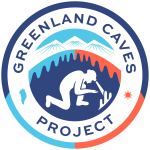In 2015 the first Greenland Caves Project expedition to northeast Greenland took place. The caves had been discovered in 1960 as part of US Army Cold War activities in the Arctic. One of these caves was reported to contain a calcite flowstone deposit that could potentially provide important information about how this region responds in a warmer and wetter world.
Going all the way to northeast Greenland to collect this sample was scientifically ‘high risk but high gain’ and without prior proof-of-concept, traditional large scientific funding grants were not available. Thankfully, many organisations and people got behind the project, and in the end the expedition was funded by 59 different sponsors for whom we are extremely grateful.
Now, we are delighted to announce that the hard work and commitment finally paid off. The open-access journal Science Advances published our paper which analysed this original 1960 flowstone. Importantly it contained a paleoclimate record spanning 549,000 to 588,000 years ago. This is the very first cave-based paleoclimate record for Greenland and has allowed us to extend our knowledge of past terrestrial climate change beyond the limit of the Greenland ice cores.
To access the paper, visit here. Data is also available for download from here.

